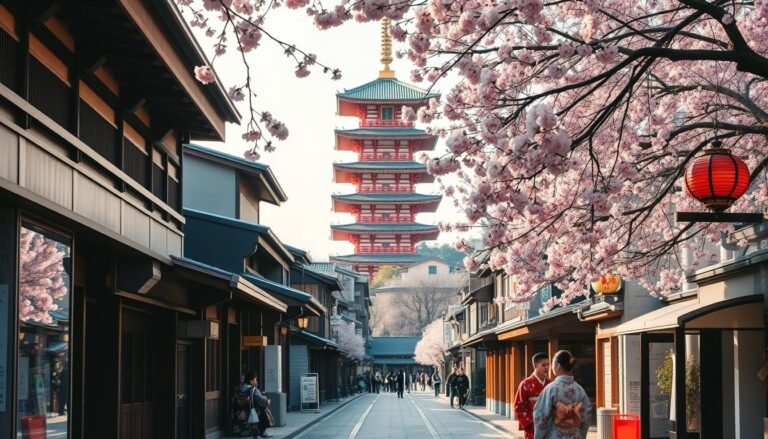
Planning a trip to Japan? Learning cultural etiquette is key for a respectful and unforgettable visit. Japan offers vibrant cities and serene traditions. Understanding local customs is essential.
Travelers often seek to connect authentically. This guide covers essential dos and don’ts for everyday interactions. Simple actions like proper bowing or silence on trains can enhance your experience. Avoiding common mistakes helps build trust with locals.
Exploring Tokyo or visiting historic temples requires cultural awareness. This guide helps you navigate Japan’s unwritten rules. Every detail, from gift-giving to temple rituals, ensures you experience Japanese hospitality fully.
Understanding the Foundations of Japanese Cultural Etiquette
Japanese culture is built on key values that shape daily life. For travelers, understanding these values makes visits more meaningful. This Japan travel guide explains important concepts like respect (keii) and harmony (wa), essential for connecting with local customs.
The Importance of Respect and Harmony in Japanese Society
Respect and harmony (wa) are at the heart of social behavior. Quiet subway cars and orderly queues show this balance. By focusing on the group’s well-being, interactions become smoother, making your trip easier.
Key Cultural Concepts: Wa, Omotenashi, and Tatemae
| Concept | Meaning | Example |
|---|---|---|
| Wa | Harmony | Avoiding conflict to maintain group cohesion |
| Omotenashi | Selfless hospitality | Restaurant staff quietly refilling tea without being asked |
| Tatemae | Social facade | Smiling through disagreements to avoid embarrassment |
How Japanese Etiquette Differs from American Customs
- Greetings: Bowing replaces handshakes
- Personal space: Closer proximity in lines vs. Western preferences
- Communication: Indirect language for politeness
- Hierarchy: More emphasis on status in interactions
These insights from the ultimate guide show why cultural awareness is key. Small gestures of respect can turn curiosity into connection.
Essential Do’s and Don’ts for Travelers in Japan
Planning a trip to Japan? Knowing the do’s and don’ts for travelers in Japan is key for a respectful Japan visit. These simple steps help tourists Japan avoid misunderstandings and embrace local traditions. Let’s explore the essential rules for a smooth traveling to Japan adventure.
| Do’s | Don’ts |
|---|---|
| Remove shoes indoors (homes, ryokans, tatami rooms) | Don’t eat walking on streets or subways |
| Carry a small hand towel (tenugui) for hand-drying | No tipping in restaurants or hotels |
| Stand left on Tokyo escalators; right in Osaka | Never stick chopsticks upright in rice bowls |
| Sort trash into precise bins (plastic, burnable, cans/bottles) | No loud phone calls on trains or shrines |
| Learn “sumimasen” (excuse me) and “arigatou” (thank you) | Avoid touching statues or historic sites |
Small gestures like these show omotenashi (hospitality) values. While minor mistakes are forgiven, showing effort shows respect. Follow these tips for a hassle-free traveling to Japan experience filled with gratitude and cultural understanding.
Japanese Greeting Customs and Body Language
Learning Japan’s greeting customs and body language makes your visit to Japan better. These small actions show respect and follow
Mastering the Art of Bowing: When and How to Bow
Bowing is key in Japanese communication. Here’s how to do it right:
| Type | Angle | Use |
|---|---|---|
| Casual Greeting | 15° | Friends, informal settings |
| Respectful Acknowledgment | 30° | Strangers, service staff |
| Formal Apologies | 45° | Business meetings, serious situations |
Even a small nod is appreciated. Locals value your effort to follow japan etiquette.
Personal Space and Physical Contact
In Japan, personal space rules are different. Here are some tips:
- Avoid staring too long in close spaces
- Don’t hug or slap backs in public
- Keep your voice down on trains and streets
Even on crowded visit to Japan trains, keep calm to respect others.
Exchanging Business Cards (Meishi) Properly
Exchanging business cards is a special ritual. Here’s how to do it:
- Take cards with both hands
- Quickly read the card before placing it on the table
- Never write on someone’s card
These actions make a strong impression, crucial at Japan 2025 business meetings.
Dining Etiquette: Navigating Japanese Table Manners
Learning Japanese dining customs makes your Japan travel better. Start by saying “itadakimasu” before eating and “gochisousama deshita” after. This shows respect for the food and your dining mates.
Chopsticks are important. Never stick them upright in rice, as it’s like a funeral ritual. Also, don’t pass food with them. Instead, lay them down on a rest or dish. Slurping noodles, like ramen, is okay—it shows you’re enjoying your meal.

Drinking customs are key too. Always pour drinks for others with both hands, not your own. When someone fills your cup, take it with both hands. Saying “Kanpai” means you’re celebrating together.
At fancy meals like kaiseki, eat each dish in order. Don’t leave food behind. In casual spots like izakayas, share plates and toast often.
Remember, use oshibori (wet towels) only for your hands, not your face. Wait to be seated at fancy restaurants; hosts will show you where to sit. These steps make meals more than just food. They’re cultural experiences. Follow these tips, and locals will appreciate your effort. The ultimate japan travel guide helps you enjoy every meal without mistakes.
Temple and Shrine Etiquette for Foreign Visitors
Visiting Japan’s temples and shrines requires respect. It’s a chance to see the spiritual heart of Japan. Knowing the local customs is essential.
Purification Rituals at Shrine Entrances
Start by using the temizuya fountain. It’s for cleaning hands and mouth:
- Pour water over left hand, then right, avoiding direct contact between the ladle and skin.
- Rinse mouth discreetly (without touching the ladle) and then tilt the handle upright to drain.
Proper Prayer Procedures
Prayers at Shinto shrines and Buddhist temples are different:
- Shinto Shrines: Toss coins, bow twice, clap twice, then bow once more. Clapping invites deity attention.
- Buddhist Temples: Light incense or ring bells before praying. Bow deeply as a sign of reverence.
Photography Rules and Restricted Areas
Always check signs before taking photos. Some rules include:
- Avoid capturing sacred objects or ongoing ceremonies.
- Ask staff permission in restricted zones. Opt for scenic exteriors if unsure.
- Turn off cameras near worshippers to respect their privacy.
A japanese tourist visa lets you visit but not ignore cultural norms. Following these steps makes your visit better and respects the site’s sanctity.
Public Transportation Etiquette in Japan
Traveling through Japan’s public transport is a big highlight for many tourist japan visitors. Following local customs makes the journey smoother. These rules show Japan’s culture values respect and order, shaping japan 2025’s transport systems.
Important rules include keeping quiet. Whisper if you must speak, and keep loud calls to a minimum. Texting is okay, but keep conversations short. When getting on, wait in the lines on platforms and let others off first.
Offer seats to those who need them, like the elderly or families with kids. Never block the aisles with your luggage. Use overhead racks or hold items close to your feet to keep the area clear.
- Follow regional escalator rules: Stand right in Tokyo, left in Osaka to let others pass.
- Show tickets until exits—staff may check them at any time.
- Avoid eating or drinking on trains unless in designated areas.
Respecting these norms makes commutes enjoyable. By 2025, Japan’s systems will be even more advanced. But, cultural awareness is still crucial. Being mindful turns you from a tourist into a considerate guest, making your travel experience better.
Gift-Giving Traditions in Japanese Culture
Gifts in japanese culture mean a lot, making them key for traveling to Japan visitors to understand. What’s polite elsewhere might not be here. Let’s dive into this thoughtful tradition.
Appropriate Gifts for Different Occasions
- Bring regional specialties like local sweets or crafts when visiting homes or offices.
- For business meetings, choose modestly priced items like stationery or regional art to show respect without being too flashy.
- Never give gifts in sets of four—this number symbolizes death due to its pronunciation similarity with “death” in Japanese.
Gift-Wrapping Significance and Protocol
Wrapping is as important as the gift itself. Most department stores offer omiyage (souvenir) wrapping services. Avoid black or white for celebratory gifts—these colors are linked to funerals. Present gifts with both hands as a sign of sincerity. Never open a gift immediately; it’s considered rude to appear eager.
Understanding the Custom of Reciprocity
Gifts often start a cycle of giri (obligation). If given a gift, return it within weeks to keep harmony. Keep exchanges balanced in value to avoid creating debt. Even small tokens like wasabi peas or matcha can be enough for casual meetings.
Mastering these traditions builds trust and deepens connections during your traveling to japan journey. The ultimate guide to japanese culture ensures your gifts become bridges, not barriers.
Common Cultural Faux Pas to Avoid During Your Visit to Japan
Even with the best travel tips Japan, mistakes can happen. These small errors have big cultural meanings. Follow these japan travel tips for respectful interactions:
- Shoes on Tatami: Never walk on tatami mats with outdoor shoes. Remove footwear in homes, ryokans, and traditional spaces.
- Onsen Rules: Wash thoroughly at shower stations before entering baths. Entering dirty water is a big no-no.
- Trash Sorting: Japan’s strict recycling means sorting waste into precise categories. Check bin labels carefully.
- Hand Gestures: Use an open palm—not fingers—to point at objects or people.
- Tattoo Restrictions: Cover tattoos in onsens. Many facilities prohibit visible ink due to historical associations.
- Modest Attire: Dress respectfully at shrines/temple. Remove hats and avoid revealing clothing during rituals.
- Quiet Spaces: Keep voices low on trains and public transport. Avoid loud conversations or phone calls.
- Eating Mindfully: Wait for group blessings before eating. Slurping noodles is okay, but burping loudly is impolite.

Travelers with a Japanese tourist visa can show respect by avoiding these pitfalls. Locals often appreciate sincere efforts—even if mistakes happen. A quick glance at this tourist Japan guide ensures you’ll leave a positive impression. Small gestures like learning basic phrases or following local norms create lasting connections with Japan’s friendly communities.
Conclusion: Embracing Japanese Culture for a Respectful and Rewarding Travel Experience
Planning a trip to Japan? The ultimate Japan travel guide shows how respect makes your visit unforgettable. Small actions like quiet meals or proper gift-wrapping show you care about Japan’s traditions. These actions reflect Japan’s values of harmony and sincerity, making your visit a shared story.
Even small details are important. The guide explains how removing shoes or exchanging meishi (business cards) build trust. Locals value your effort, not perfection. Simple actions like mindful dining or visiting shrines create connections, turning sightseeing into cultural exchange.
Your journey will be richer when you embrace these principles. The guide helps you engage thoughtfully, from using public transport to visiting temples. By respecting local customs, you’ll discover Japan’s true spirit. Respectful travel is about curiosity and kindness, leaving you with lasting memories.
FAQs
1. What are the essential things to know before visiting Japan?
Before you go to Japan, learn about the culture’s importance of respect and harmony. Knowing basic Japanese phrases and dining etiquette can make your trip better. Also, understanding public behavior is key.
2. Do I need a visa to visit Japan as a tourist?
Yes, most tourists need a Japanese tourist visa. Check if your country is exempt. Always confirm with your local embassy or consulate.
3. What are some common cultural faux pas to avoid in Japan?
Don’t wear outdoor shoes indoors, speak loudly, or tip at restaurants. These actions are seen as rude. Also, sort trash correctly and respect people’s space.
4. Is it necessary to learn some Japanese for my visit?
Many Japanese speak English, but learning basic phrases is helpful. It shows respect for their culture. It can also lead to more meaningful interactions.
5. How should I behave on public transportation in Japan?
Keep quiet on public transport. Use texts instead of phone calls. Always wait in lines and let others exit first.
6. What are the dining etiquettes I should follow in Japan?
Say “itadakimasu” before eating and “gochisousama deshita” after. Don’t stick chopsticks in rice or pour your own drink. Serve others instead.
7. What types of gifts are appropriate when visiting someone’s home in Japan?
Bring quality items like sweets or fruit from your country. Present gifts with both hands to show respect.
8. How should I handle my camera when visiting temples and shrines?
Follow photography rules at temples and shrines. Some areas may be off-limits. Always ask permission and be respectful of others.
9. What should I know about the 2025 travel plans for Japan?
Japan is improving tourist facilities for 2025. Expect better infrastructure. It’s a great time to explore Japan’s culture and events.






